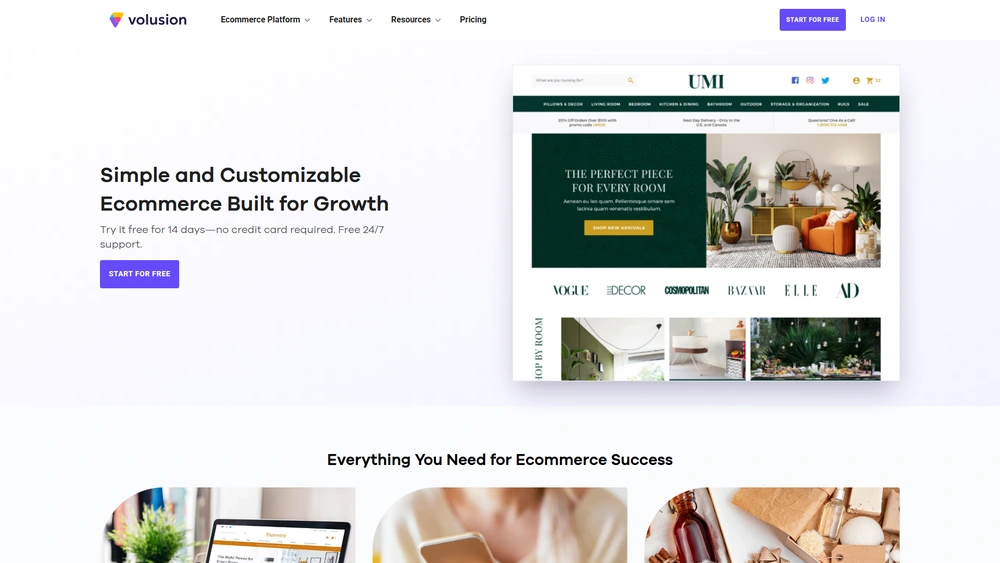Volusion Overview & 2025 Industry Position
Volusion is a long-established eCommerce platform designed to help small and mid-sized businesses quickly launch, manage, and grow online stores. In 2025, it distinguishes itself through usability-focused improvements, entry-level AI capabilities, and competitive pricing for entrepreneurs launching new digital ventures. While major competitors focus on enterprise scaling or massive ecosystems, Volusion stays rooted in delivering streamlined, essentials-first solutions ideal for solo founders, boutique retailers, and cost-sensitive SMBs.
From Launch to 2025 Journey
Launched in 1999 by Kevin Sproles, Volusion initially focused on web design and later pivoted to offer eCommerce software by 2002. Through the mid-2000s, it grew in popularity, especially among independent merchants seeking a DIY online store builder. In 2009, Volusion reached over 100,000 merchants. The platform launched multiple refreshed versions between 2016 and 2019, shifting toward a more visual builder interface.
Key milestones include:
- 2002: Volusion launches its proprietary shopping cart software.
- 2009: Hits 100,000+ users with significant growth in SMB segments.
- 2015: Introduces theme engine and responsive templates.
- 2019: Redesigns the store builder UI for a drag-and-drop experience.
- 2020: Files Chapter 11 and reemerges with a tightened SMB focus.
- 2023: Rolls out early AI integrations for inventory and SEO.
In 2025, Volusion’s strategy centers on fast-deploy commerce: enabling merchants to launch professional storefronts in under a week, with native analytics and simplified operations for non-technical users.

Volusion Key Features
Volusion’s feature set balances essentials with beginner-friendly tools, offering strategic efficiency without the bloat. Key highlights include:
- Drag-and-Drop Store Builder: Visual layout tools with mobile-responsive templates
- Built-in Product Management: Inventory, variants, rich product photos, and real-time stock levels
- SEO Tools: Customizable meta data, sitemaps, and 301 management
- AI Product Suggestions: Lightweight AI to auto-generate product tags and descriptions
- Marketing Integrations: Email capture forms, native discount engine, social media tools
- Responsive Checkout: Clean mobile-optimized checkout reducing cart abandonment
- Native Support Tools: Email/chat support plus an AI Assistant (beta) for help walkthroughs
Workflow & UX
Volusion is known for ease of use, particularly in 2025 thanks to UX updates tailored to solo operators with minimal tech background. While visuals remain simple, navigation is consistent and categorized intuitively. Highlights include:
- Clear sidebar navigation (Products, Design, Marketing, SEO, Reports)
- Minimalist UI aesthetic, reduces screen clutter for new users
- Wizard onboarding flows help populate the first store layout
- Real-time preview panel during theme edits
Pro Tip: Use Volusion’s launch wizard with sample data loaded — it saves hours for testing before going live.
Volusion Pricing Analysis & Value Metrics
As of July 2025, Volusion pricing remains transparent and favorable compared to Shopify or Wix for stores under 500 SKUs. Here’s a breakdown:
| Plan | Monthly Price | Key Features |
|---|---|---|
| Personal | $38 | 100 SKUs, 1 staff, standard templates |
| Professional | $78 | 5,000 SKUs, 5 staff, phone support, API access |
| Business | $198 | Unlimited SKUs, analytics, integrations, priority support |
| Prime | Custom Quote | High-volume merchants, custom infra, account manager |
Value Assessment: Competitive for growing solo shops. Cost-effective starting at the Professional plan; slightly underpowered in the free trial or lowest tier.
Competitive Landscape
| Platform | Best For | Strength | Limitation |
|---|---|---|---|
| Volusion | SMBs < 5K SKUs | Simplified UX | Fewer add-ons |
| Shopify | High-scale DTC | App ecosystem | Higher TCO |
| Wix eCommerce | Beginners | Visual design tools | Weaker inventory tools |
| BigCommerce | B2B firms | B2B cart logic | Complex interface |
Use Cases & Ideal Businesses
- Artisan or handmade goods shops scaling beyond Etsy
- Low-inventory DTC brands testing product-market fit
- Vertical-specific stores (beauty, supplements, apparel)
- Service-plus-product bundles with limited SKUs
Volusion Integrations & Ecosystem
In 2025, Volusion supports 70+ integrations, primarily via native channels or Zapier. Notable include:
- Payments: Stripe, Square, PayPal, Authorize.net
- Shipping: USPS, UPS, ShipStation
- Email & CRM: Mailchimp, HubSpot
- Marketing: Meta Pixels, Google Ads, Feedonomics
Pros & Cons
- ✅ Pros: User-friendly interface, clean templates, affordable plans, good SEO controls, native support tools
- ❌ Cons: Limited apps ecosystem, fewer design customizations, legacy elements still in dashboard
Final Thoughts
For founders seeking a fast, budget-friendly launch into eCommerce without drowning in complexity, Volusion delivers in 2025. It’s not the most cutting-edge platform, but it’s refreshingly focused on the needs of smaller sellers. Those needing enterprise extensions or deep app customization may consider Shopify or BigCommerce, but Volusion excels when cost simplicity and usability matter most.
Volusion FAQ
Yes, Volusion offers a 14-day free trial with no credit card required, letting users test templates, builder, and product setup.
Volusion supports digital products, and file delivery links are auto-sent upon purchase.
Yes, you can connect your existing domain or buy one through Volusion during setup.
No, Volusion does not charge additional transaction fees beyond your payment provider’s standard rates.
Yes, Volusion offers migration tools and support documentation for switching from other platforms.